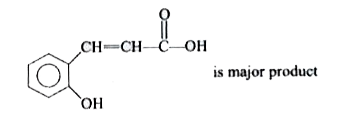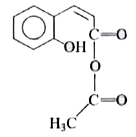I2+Na2CO3 "soln." Hot−−→X+Y
If 'X' gives coloured ppt. with Pb(CH3COO)2 solution, then 'Y' will respond to which of the following ?
Y+H+(aq.)+H2S
Y+Cr2O2−7(aq.)+OH−(aq.)
Y+H+(aq.)+SO2
Y+H+(aq.)+I−(aq.)
The correct Answer is:A, B, D
To solve the problem, we will follow these steps:
Step 1: Identify the Reaction
We start with the reaction between iodine (I₂) and sodium carbonate (Na₂CO₃) in hot conditions. The reaction can be summarized as:
I2+Na2CO3→X+Y
Step 2: Determine the Products
When iodine reacts with sodium carbonate in hot conditions, it produces iodide ions (I⁻) and iodate ions (IO₃⁻). Thus, we can identify:
- X=NaI (sodium iodide)
- Y=IO−3 (iodate ion)
Step 3: Analyze Product X
The problem states that 'X' gives a colored precipitate with lead acetate (Pb(CH₃COO)₂). When sodium iodide (NaI) reacts with lead acetate, it forms lead iodide (PbI₂), which is a yellow precipitate:
NaI+Pb(CH3COO)2→PbI2(s)+CH3COONa
Step 4: Identify the Response of Product Y
Now, we need to determine how 'Y' (IO₃⁻) responds to various reactions. We will evaluate the options given in the question.
1. Option A: IO−3+H++H2→ (forms a precipitate)
- This is a valid reaction where IO₃⁻ can react under acidic conditions.
2. Option B: IO−3+Cr2O2−7+OH−→ (no reaction)
- This is correct because dichromate does not exhibit oxidizing properties in alkaline medium.
3. Option C: IO−3+H++SO2→ (forms sulfate and I₃⁻)
- This is also a valid reaction where IO₃⁻ can react with sulfur dioxide.
4. Option D: IO−3+H++I−→ (comproportionation reaction)
- This reaction is valid as well, resulting in the formation of I₂.
Conclusion
From the analysis, we find that 'Y' (IO₃⁻) responds to options A, C, and D, but not to option B.
Final Answer
Thus, the correct options for the response of 'Y' are A, C, and D.
---
We start with the reaction between iodine (I₂) and sodium carbonate (Na₂CO₃) in hot conditions. The reaction can be summarized as:
I2+Na2CO3→X+Y
When iodine reacts with sodium carbonate in hot conditions, it produces iodide ions (I⁻) and iodate ions (IO₃⁻). Thus, we can identify:
- X=NaI (sodium iodide)
- Y=IO−3 (iodate ion)
The problem states that 'X' gives a colored precipitate with lead acetate (Pb(CH₃COO)₂). When sodium iodide (NaI) reacts with lead acetate, it forms lead iodide (PbI₂), which is a yellow precipitate:
NaI+Pb(CH3COO)2→PbI2(s)+CH3COONa
Now, we need to determine how 'Y' (IO₃⁻) responds to various reactions. We will evaluate the options given in the question.
- This is a valid reaction where IO₃⁻ can react under acidic conditions.
- This is correct because dichromate does not exhibit oxidizing properties in alkaline medium.
- This is also a valid reaction where IO₃⁻ can react with sulfur dioxide.
- This reaction is valid as well, resulting in the formation of I₂.
From the analysis, we find that 'Y' (IO₃⁻) responds to options A, C, and D, but not to option B.
Thus, the correct options for the response of 'Y' are A, C, and D.
Topper's Solved these Questions
- BOOK - VK JAISWAL ENGLISHCHAPTER - TYPES OF REACTIONSEXERCISE - MATCH THE COLUMN14videos
TYPES OF REACTIONS
- BOOK - VK JAISWAL ENGLISHCHAPTER - TYPES OF REACTIONSEXERCISE - SUBJECTIVE PROBLEMS42videos
TYPES OF REACTIONS
- BOOK - VK JAISWAL ENGLISHCHAPTER - TYPES OF REACTIONSEXERCISE - LEVEL 344videos
TYPES OF REACTIONS
- BOOK - VK JAISWAL ENGLISHCHAPTER - s-BLOCK ELEMENTSEXERCISE - SUBJECTIVE PROBLEMS2videos
s-BLOCK ELEMENTS
Similar Questions
Knowledge Check
- Question 1 - Select One or More
When salicyl aldehyde is treated with (CH3CO)2O in presence of CH3COOϴNa⊕,Δ,
A is major productB
is major productB is the major productC
is the major productC is formed as intermediate, which finally condense and form the product.DThis reaction is Perkin condensation
is formed as intermediate, which finally condense and form the product.DThis reaction is Perkin condensation
When cyclohexanone is treated with Na2CO3 soln, we get
View SolutionFeCr2O4+Na2CO3+O2Fusion−−−→[X]H+−−−−−→H2O[Y]H2O/H+−−−−−→[Z]
Which of the following statement is true for the compounds [X], [Y] and [Z]?View SolutionWrite the chemical name of the (CH3COO)2Pb ?
View SolutionFeCr2O4+Na2CO3+O2Fusion−−−→[X]H+YH2OH+−−→H2O2[Z]
Whichf of the following statement is true for the compounds [X], [Y] and [Z]?View SolutionCH3CNNa+C2H5OH−−−−−−−−→X
The compound X isView SolutionIdentify the following:
Na2CO3So2−−→ANa2CO3−−−−→BElement s−−−−−→ΔCI2−−→D
Also mention the oxidation state of S in all the compounds.View SolutionA colourless inorganic compound (A) imparts a green colour to the flame. Its solution gives a white ppt. (B) with H2SO4. When heated with K2Cr2O7 and conc. H2SO4, a brown red vapour/gas (C) is formed. The gas/ vapour when passed through aqueous NaOH solution, it turns into a yellow solution (D) which forms yellow precipitate (E) with CH3COOH and (CH3COO)2Pb. with reference to above information, answe the following questions.
Q. The yellow ppt. formed when (D) reacts with CH3COOHand(CH2COO)2Pb is:View Solution

